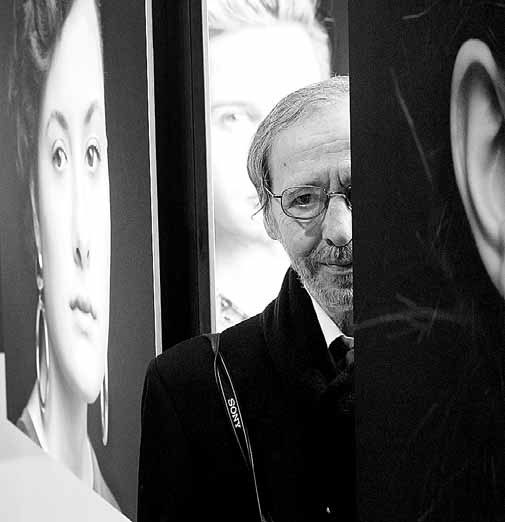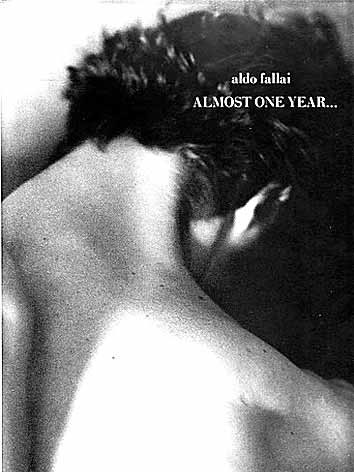An eye for glamour
Updated: 2013-03-24 08:08
By Xu Junqian(China Daily)
|
|||||||||
|
Aldo Fallai's latest exhibition, Bravo Portraits, celebrates the opening of an Italian fashion institute in Shanghai. Gao Erqiang / China Daily |
|
Fallai's favorite photo book, Almost One Year, has very little to do with fashion. |
|
The "lucky accident" when Fallai met Giorgio Armani led Fallai to become one of the world's most celebrated fashion photographers. Photos Provided to China Daily |
Aldo Fallai brought fashion fantasies to life for decades, but he got his start by accident, he tells Xu Junqian in Shanghai.
For Aldo Fallai, a one-time painter and art teacher, it took just an impulsive whim and "a very young age" to grab a camera and shoot images for six pages of the fashion bible Vogue some 40 years ago. But to be the photographer of the earliest and some of the best campaigns of style luminaries such as Giorgio Armani, Salvatore Ferragamo and Valentino, the now 70-year-old Italian says it's more about talent, or passion, or creativity ...
"You need to love art, music, dance, movie, theater, to travel, and, to live fashion," says Fallai, one of Italy's - and the world's - top fashion photographers.
If Giorgio Armani builds his sterling reputation in the fashion history for tailoring and dressing a revolutionarily sleek-silhouetted age of men, Fallai is the pioneer who can make a beautiful and elegant man step through the lens.
"Before him, nobody can 'camera-see' the beauty of a man," says Roberto Riccio, managing director of Marangoni Group, who invited Fallai to mount a show for the opening of the Italian fashion institute's Shanghai branch. The exhibition, Bravo Portraits, is a collection of black-and-white images taken by Fallai of the institute students in Milan.
Looking back at his career as a fashion photographer, Fallai says it was a lucky accident when he met Giorgio Armani - before he was "the Giorgio Armani" - at a private party in the 1970's.
"We both freelanced for a T-shirt company, where he was the designer, and I was the one who painted the print on the T-shirt. And then at this party, he asked me if I knew a photographer who can do a six-page project of Vogue, and I said I would try", he recalls.
"I had taken pictures for myself, but never for fashion magazines," he says, jokingly. "I was very young and stupid," he says, but confident that he could do it.
That brash confidence has paid off. Fallai's photo shoots have been famous for a refined aesthetic and formal purity, recognizable from his early work to his latest photographic forays. He presents a distinct sensibility in the capturing of bodies and faces.
Fallai says he doesn't know how many stars of the fashion world he has worked with, or how many Vogue covers he can claim. Maybe he was never counting.
But the prolific and energetic photographer does have a favorite: Almost One Year, a photo book that has very little to do with fashion, something he created with complete freedom. A volume of photos "taken in moments of inspiration" throughout the year of 1992 during his world tour, the book is described, by the late Italian art historian Federico Zeri, as "a diary by a great artist of the camera, a journal written not in pen and ink ..."
One distinction of the book is the photographer's sensual portrayal of men and women, reminiscent of those muscular, well-proportioned bodies of the Greek and Roman sculptures, thanks to his adept use of light, shadow and details.
Born long before Photoshop was invented and a master of light and shadow, Fallai states that he barely uses "the thing" not only because there are the risks of "having the same picture all around" and "the embellished products becoming the taste of the mass". But he also says Photoshop is a tool only for someone who used the wrong light, or making people look different than they really are. Making a fat person look thinner is not his game. "There is no ugly people in the world," he says.
The Florence-based photographer believes his aestheticism is "born in the blood of an Italian", and should never be exhausted. "In Florence, the center (of art), every morning I see is the door, the palace, the 40 percent of world art heritage," as he puts it.
"And the Forbidden City," he adds abruptly on his list of inspirations.
The globe-trotter recalls seeing the "one of the most beautiful things on earth" at his first visit to China four or five years ago, on a day that was -28 C.
The frozen weather and long hours of flight, however, didn't stop him from taking a look at a complex "that was built all for one person, the emperor".
"Even being so tired and cold, I remembered the strong emotion brought up," he says, calling himself an ardent lover of Chinese culture. He's a huge fan of the latest Oscar-winning director, Taiwan-born American Ang Lee, and his martial-arts epic Crouching Tiger, Hidden Dragon.
Any Chinese faces he would like to shoot? The Crouching Tiger, Hidden Dragon actress, Zhang Ziyi, though he cannot conjure up her name.
"My dream," says Fallai, in English, over his Italian-English translator.
Contact the writer at xujunqian@chinadaily.com.cn.
(China Daily 03/24/2013 page4)


